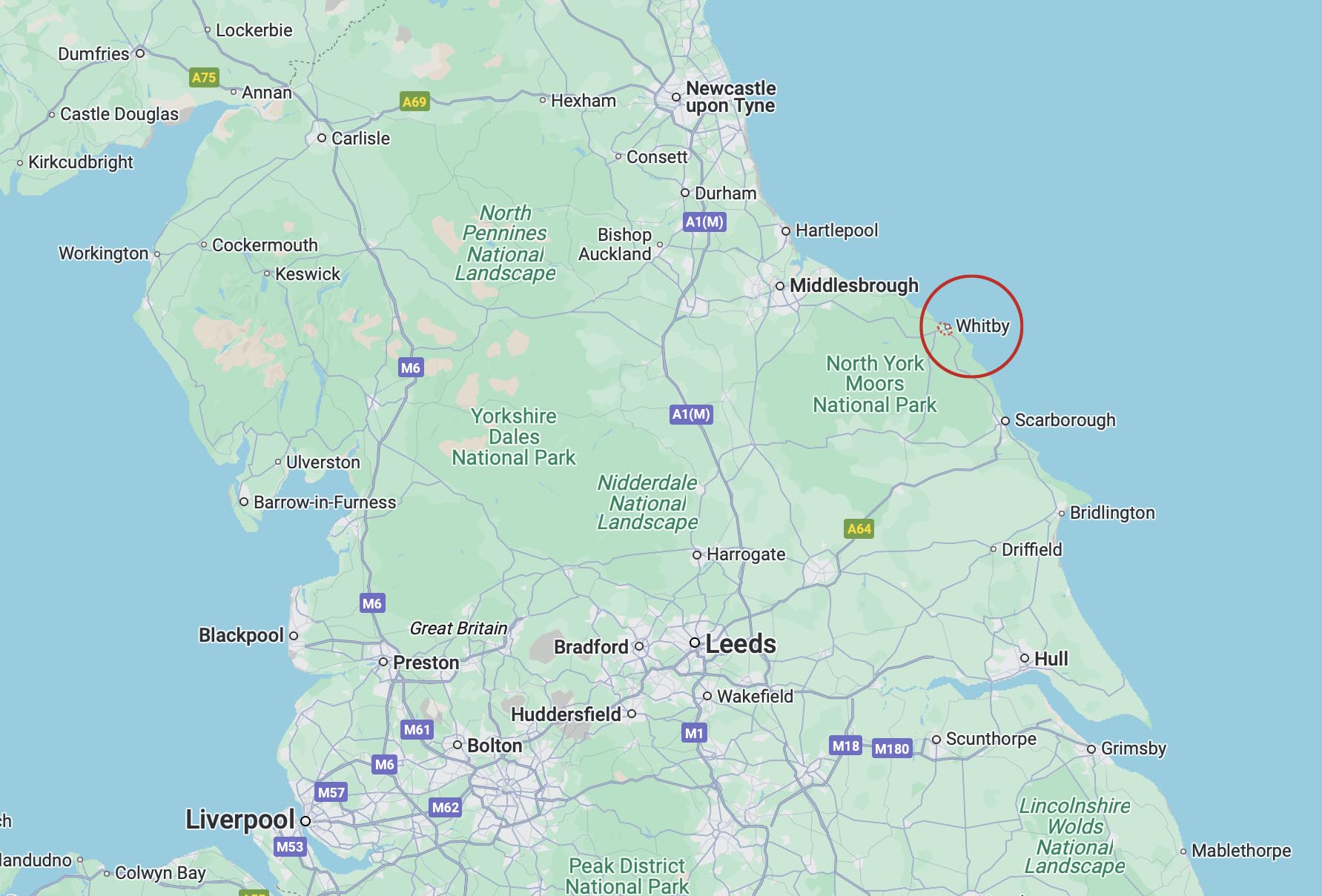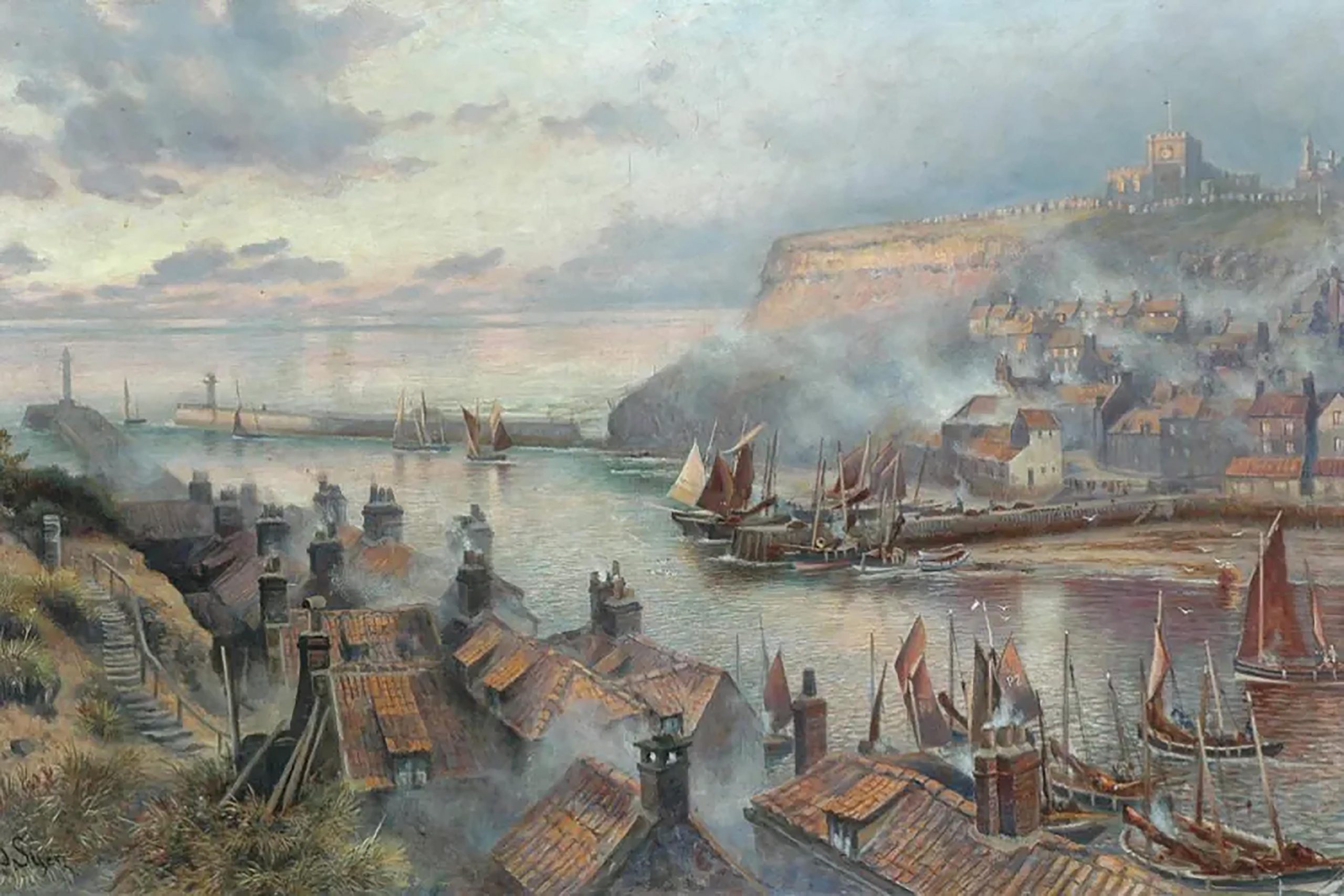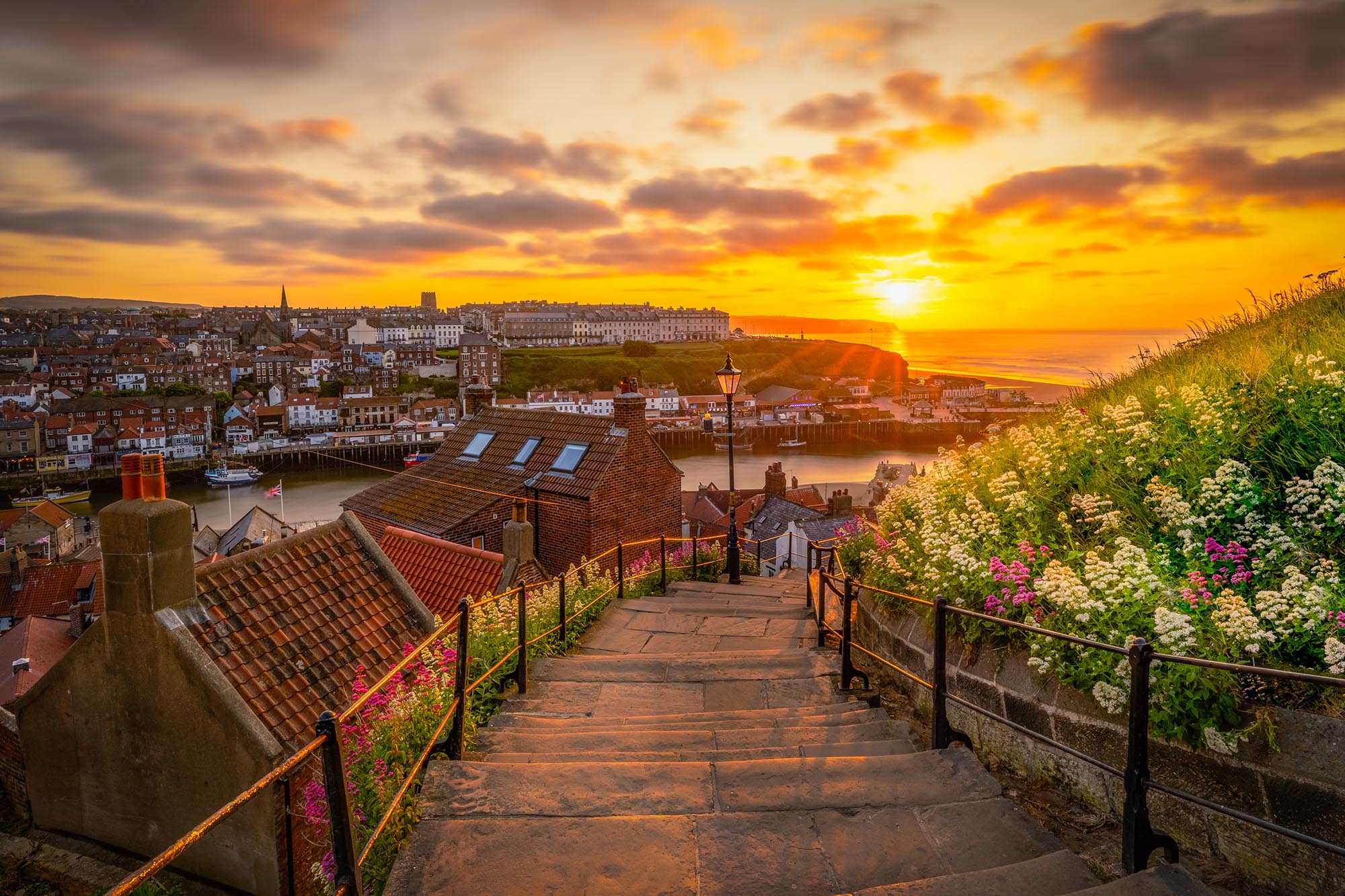Whitby, England: A historic Seaside Town in Yorkshire
Nestled along the dramatic coastline of North Yorkshire, Whitby is one of England’s most charming and picturesque seaside towns. Famous for its rugged beauty, historical sites, and connections to literature and legends, Whitby offers something for every type of traveler. Whether you’re a history enthusiast, a nature lover, or simply someone looking for a relaxing getaway, Whitby, England, should be at the top of your travel list.
In this post, we’re going to take you on a journey through Whitby’s history, attractions, hidden gems, and practical tips for visiting. So, grab a cup of tea (or a traditional Whitby fish and chips!) and let’s dive into what makes this North Yorkshire town a must-see destination.

The historic Whitby, England from above by drone
What is Whitby, England?
Whitby is a small, historic seaside town located on the east coast of England, in North Yorkshire. Situated on the edge of the North Sea, Whitby is renowned for its stunning landscapes, dramatic cliffs, and its deep connection to both maritime history and British literature. The town has a population of around 13,000 people and is a popular destination for tourists, drawing visitors year-round with its scenic charm and fascinating history.
It’s easy to see why Whitby is so loved by locals and visitors alike. The town is full of character, from its narrow cobbled streets and whitewashed cottages to its bustling harbor and the stunning abbey that looms over the town. Not only is it a beautiful place to visit, but Whitby is also packed with stories, myths, and legends, making it a fascinating destination.

where is whitby in England?
Whitby is a historic seaside town located on the North Yorkshire coast in England. Nestled between the cliffs of the North Sea, it lies around 30 miles east of Middlesbrough, 40 miles north of Scarborough and York is 40 miles south-west of Whitby Known for its picturesque harbor and stunning coastal scenery, Whitby is a popular destination for both tourists and locals. The town is easily accessible by car, train, and bus, making it a convenient and charming spot to explore the beauty of England’s northern coastline. Whether you’re walking along its sandy beaches or visiting its iconic Abbey, Whitby offers a unique slice of England’s rich history and natural beauty.

Whitby’s LONG History
Whitby’s history stretches back centuries, and this rich heritage is woven into nearly every corner of the town. Originally a small fishing village, Whitby has been shaped by its location on the North Sea. The town’s maritime history goes way back to the 7th century when Whitby Abbey was founded by St. Hilda. The abbey became an important center for Christianity in early medieval England and is often associated with the Synod of Whitby in 664 AD, where key decisions about the Christian church were made.
Maritime Heritage, James Cook & The Fishing Industry
Whitby’s deep connection to the sea is impossible to ignore. Historically, the town was a hub for the fishing industry, particularly for whaling and shipbuilding. Whitby was also home to the famous Captain Cook, one of Britain’s most renowned explorers, who learned his trade here in the 18th century. He later went on to chart the Pacific Ocean and make some of the most important discoveries in the history of navigation.
The town’s maritime history is celebrated today at the Whitby Museum and Captain Cook Memorial Museum. The latter is located in a house where Cook himself once lived, and it’s a fantastic place to learn more about his life and the impact he had on the world.

An old painting of a bustling Whitby harbour by John Syer (1844–1912) ‘Whitby Harbour from the West Side’ Whilst the houses to the right are on longer there – over the river retains a lot of the older buildings.
The Connection to Dracula
Whitby’s claim to international fame comes largely from one particular visitor: Bram Stoker, the author of Dracula. Stoker visited Whitby in 1890, and the town became the inspiration for some of the most famous scenes in his gothic horror novel. The dramatic Whitby Abbey ruins, perched high above the town, are said to have been the inspiration for Dracula’s eerie home. In fact, many parts of Dracula were directly influenced by Stoker’s time in Whitby, from the eerie atmosphere to the description of the town itself.
Stoker’s presence in Whitby is commemorated by several locations around town, most notably the Dracula Experience attraction and the 199 Steps, which lead up to the Abbey. For fans of gothic literature, Whitby is practically a pilgrimage.

A replica of captain James Cook’s ship, The Endeavour saling into Whitby Harbour
Things to Do in Whitby, England
Whether you’re strolling along the cobbled streets, admiring the scenic views, or learning about the town’s rich history, there’s no shortage of things to do in Whitby. Let’s break down some of the top attractions and experiences you absolutely can’t miss.
1. Whitby Abbey
No visit to Whitby would be complete without a trip to the iconic Whitby Abbey. This medieval ruin is perched on a dramatic cliff overlooking the town and the North Sea, offering one of the most stunning views in the region. The abbey has stood for over 1,000 years, and its imposing structure evokes a sense of mystery and awe.
Whitby Abbey is also famous for its connection to Dracula, where the fictional Count Dracula is said to have arrived by ship and climbed the 199 Steps that lead up to the abbey. Today, visitors can explore the ruins, learn about the history of the site, and enjoy spectacular views of the town below. The abbey is managed by English Heritage, and there are plenty of interactive exhibits and tours to help bring its fascinating history to life.
2. The 199 Steps
For a great view of Whitby and a bit of exercise, head over to the 199 Steps, which lead up to Whitby Abbey. These steps have been a part of Whitby’s history for centuries, and climbing them offers a rewarding view of the town and coastline. As you make your way up, take time to appreciate the beautiful, narrow streets of Whitby’s Old Town, which are full of charming shops, cafes, and historic buildings.

Walking the 199 Steps to the Whitby Abbey are a must do activity and even better if you can do it at sunrise! Photo by Ash Foster
3. Whitby’s Beaches
Whitby’s coastline is a major draw for visitors, offering sandy beaches and dramatic cliffs that make for fantastic walks and picturesque views. Whether you prefer relaxing by the sea, building sandcastles with the kids, or braving the waves for a bit of surfing, Whitby’s beaches have something to offer.
The West Cliff Beach is one of the most popular, located near the town’s main attractions. It’s perfect for a traditional day at the seaside, with plenty of room for picnics and long walks along the shore. There’s also the quieter Sandsend Beach just a little further down the coast, ideal if you’re looking for a more tranquil spot to relax.
4. Whitby Harbour and the Fish Market
Whitby’s harbor is at the heart of the town, and there’s something undeniably charming about wandering along the quayside. The harbor has been in use for over a thousand years, and it’s still an active fishing port today. The sight of colorful fishing boats and the salty sea air create a quintessential coastal atmosphere.
Don’t miss out on the chance to sample some of Whitby’s famous fish and chips, which are a local delicacy. Many fish and chip shops near the harbor serve up delicious, freshly caught fish, often with a side of mushy peas. Whether you eat at one of the town’s classic chip shops or take your meal to the beach, Whitby’s fish and chips are an experience in themselves.
5. Captain Cook Memorial Museum
If you’re fascinated by the life of Captain Cook and his exploration of the Pacific, a visit to the Captain Cook Memorial Museum is a must. This small but fascinating museum is housed in the building where Cook worked as an apprentice before setting off on his famous voyages.
The museum is packed with exhibits related to Cook’s life and work, including maps, ship models, and personal items from his journeys. It’s a great way to learn more about one of Whitby’s most famous historical figures.
6. The Dracula Experience
If you’re a fan of gothic literature and Bram Stoker’s Dracula, the Dracula Experience in Whitby is a must-visit. This interactive attraction takes you through some of the most iconic scenes from the novel, with eerie special effects and atmospheric lighting. It’s a fun (and slightly spooky) experience for fans of horror and mystery, and it really brings Whitby’s connection to Dracula to life.
7. Whitby Museum
The Whitby Museum is another great place to learn more about the town’s long history. Located in Pannett Park, the museum boasts a diverse collection, including artifacts from Whitby’s maritime history, fossils from the surrounding coastline, and works of art inspired by the town’s scenic beauty. If you’re interested in local history, this museum is a hidden gem.
8. St. Mary’s Church
St. Mary’s Church is a historic and beautiful place of worship located at the top of the 199 Steps. The church’s striking graveyard, with its old tombstones and sea views, is an atmospheric spot that adds to Whitby’s gothic charm. The church itself is also worth exploring, with its stunning stained-glass windows and peaceful interior.

Whitby’s streets are always bustling with activity and are well worth a wander
FOOD & DRINK IN WHITBY
Food lovers will find Whitby equally captivating, as the town is famous for its fresh seafood, particularly its fish and chips. Many visitors flock to Whitby’s traditional fish and chip shops, such as teh iconich Magpie Cafe, to taste the iconic dish, often served with a side of delicious mushy peas. Whitby also boasts a variety of quaint cafes and pubs, offering the perfect spots to relax and soak in the coastal atmosphere. With its mix of stunning scenery, rich history, and mouthwatering food, Whitby is undoubtedly a must-visit destination for anyone exploring England.
Best Time to Visit Whitby IN ENGLAND
Whitby is a year-round destination, but the best time to visit depends on what kind of experience you’re looking for.
-
Summer (June to August) is the busiest time to visit Whitby. The town is alive with tourists, and there are plenty of festivals, outdoor activities, and events to enjoy. The weather is generally warm, and it’s perfect for beach trips and outdoor exploration.
-
Spring (March to May) and Autumn (September to November) are also great times to visit if you prefer fewer crowds and a quieter experience. The weather can still be pleasant, especially in late spring or early autumn, and the town looks particularly picturesque during these seasons.
-
Winter (December to February) is the quietest time to visit, and while the weather can be cold and windy, there’s something magical about Whitby in the winter months. With fewer tourists around, you can enjoy the town’s attractions at a more relaxed pace. Plus, the winter months bring the opportunity to see the stunning coastline with fewer distractions.
Conclusion: Why Visit Whitby, England?
Whitby, England, is one of those places that stays with you long after you’ve left. With its rich history, breathtaking coastal views, and a perfect blend of old-world charm and modern-day amenities, Whitby offers something for everyone. Whether you’re interested in the history of Captain Cook, the mysteries of Dracula, or simply the beauty of the seaside, this quaint North Yorkshire town has it all.
So, if you’re looking for a coastal getaway that combines stunning scenery, intriguing history, and plenty of things to see and do, Whitby should be on your radar. Plan your visit to Whitby, and you’ll quickly see why this lovely town continues to capture the hearts of travelers from all over the world.
What is Whitby famous for?
Whitby is famous for its picturesque harbor, stunning coastline, and rich history. It is closely associated with Bram Stoker’s Dracula, with the town’s dramatic Whitby Abbey serving as an inspiration for parts of the novel. Whitby is also known for its maritime heritage, being the birthplace of Captain James Cook, one of England’s most famous explorers. Additionally, the town is renowned for its delicious fish and chips, with several shops offering this iconic English dish.
How do you get to Whitby from London?
To get to Whitby from London, the easiest option is to take a train. You can catch a direct train from London King’s Cross to Whitby with a transfer at Middlesbrough, which takes around 3 to 4 hours in total. Alternatively, you can drive, with the journey taking about 4 to 5 hours, depending on traffic. The A1(M) motorway and the A174 road lead you directly to Whitby. There are also bus services available, although they typically take longer.
When is the best time to visit Whitby?
The best time to visit Whitby is during the spring and summer months (April to September) when the weather is milder, and there are plenty of festivals and events, such as the Whitby Goth Weekend and the Whitby Regatta. However, if you prefer quieter periods, visiting in the autumn or winter months can be just as beautiful, especially if you enjoy walking along the beach or visiting the town’s historic sites without the summer crowds.
What can you do in Whitby?
There are plenty of things to do in Whitby, whether you enjoy history, nature, or local cuisine. Visit the iconic Whitby Abbey for stunning views and a taste of history, explore the charming old town with its cobbled streets, or relax at one of the many beautiful beaches. If you love literature, don’t miss out on the connections to Dracula. You can also enjoy a boat tour of Whitby Harbor, walk the coastal paths, or indulge in fresh seafood, particularly at the famous fish and chip shops.
Is Whitby a good destination for families?
Yes, Whitby is an excellent destination for families. The town offers a variety of family-friendly activities, including visits to the beach, exploring the Whitby Abbey ruins, or learning about the area’s history at the Whitby Museum. Children will also love the fun of climbing the 199 steps to the abbey, and the town’s amusements and arcades provide plenty of entertainment. The scenic surroundings are ideal for outdoor activities, making Whitby an ideal location for a family vacation.





0 Comments